- Home
- Patricia Cornwell
Dust Page 18
Dust Read online
Page 18
“He was an inspector in place and on the White House’s National Security Staff,” Benton says. “The details about Martin Lagos’s abuse were never in your office records.” He changes the subject back to that. “There was never anything in the police report. The medical examiner didn’t need to know and it would have served no useful purpose for the media to get its hands on such an accusation. That was the decision.” Not Benton’s decision but someone else’s.
“Do you believe the abuse happened?”
“From what I’ve read in the diary, yes.”
Marino is midway in the shadowy tunnel now, Quincy straining toward us with his tongue hanging out. It looks like he’s grinning.
“I’d like to review the Gabriela Lagos case to refresh my memory,” I say to Benton. “Everything you have on it. I’d rather not go through Virginia. Nobody wants a former chief meddling. My input wouldn’t be welcome.” I have more than one reason.
If there’s a problem with Martin Lagos’s DNA, I’m certainly not tipping my hand by calling the office that handled the original analysis even though I was in charge of it at the time, in 1996. If something has happened, it’s happened since I was chief, possibly very recently, as recently as the third victim’s murder, which wasn’t even a month ago.
“I can get you a lot more than your former office can as long as I don’t clear it with Granby,” Benton says. “He won’t say no. It just won’t happen and then other things will.”
“As soon as I can get anything that might relate to what’s going on,” I reply. “You think my case here is connected to the ones in D.C., so let me look at the evidence. I have that right and jurisdiction. Let’s compare the DNA, let’s compare the fibers to what I’ve recovered from this morning. Give me everything you’ve got as quickly as you can.”
“Leave it!” Marino orders his dog.
“The DNA is harder,” Benton says.
“Heel!” Marino’s voice echoes inside the tunnel, where Quincy is pulling him around. “Shit!”
“I can e-mail the microscopic images of the fibers,” Benton says. “But the DNA profiles have to come from CODIS and I can’t access that directly. I’d have to put in a formal request.”
“Who did the original analysis in Julianne Goulet’s case?”
“The Maryland medical examiner’s office. Baltimore.”
“I know the chief very well.”
“You can trust him without reservation?”
“Absolutely.”
Quincy sloshes into a puddle and drinks from it and Marino yells, “No! Leave it! Dammit!”
“About the time it’s believed Gabriela Lagos died an anonymous caller reported witnessing a young male jumping from the Fourteenth Street Bridge into the Potomac at night,” Benton tells me. “The body was never found.”
“Never?” I question. “That strikes me as strange.”
“No drinking puddles!” Marino is the one barking.
“Were you the profiler on her case?” I don’t remember Benton ever telling me at the time that he was involved in Gabriela Lagos’s homicide.
“I was consulted, yes. Not about her but about Martin and what was in his diary” is all Benton says, and Marino has reached us.
Benton holds out his hand to encourage Quincy to come. “That’s a good boy.” He ruffles the German shepherd’s neck. “I can see you’re very well trained,” he says with quiet sarcasm.
“He’s sure as hell not being good,” Marino is grumpy and out of breath. “Don’t be a bad boy.” He pats his dog, thumping him on the sides. “You know what to do. Now, sit.”
Quincy doesn’t.
22
Not far up ahead but out of sight from where we wait is a Bank of America kiosk.
“At Mass Ave and Albany. It would have been an ideal place for the killer to leave his car,” Benton describes the very intersection where I get stopped on occasion when the circus train lumbers through.
The last time wasn’t that long ago, the first of December, when the long candy-apple-red train with gold lettering on the sides took forever to clatter past, headed into the MIT campus to park at the Grand Junction branch. I sat and imagined the exotic animals inside those cars, remembering when this same Florida-based circus performed in Miami several times a year during my childhood. The Cirque d’Orleans casts a shadow over my mood every time it sets up in an arena around here, reminding me of my past, of my father who used to take me to see the elephants walking trunk to tail along Biscayne Boulevard.
“He could have left his car there in the public lot.” Benton continues talking about where the killer may have parked as I hold Quincy by his leash and pet him. “And nobody would have paid attention. Cars are in and out of that lot at all hours because of the ATM. He left his vehicle and returned on foot probably right along these tracks. It would have been raining when he did. The footprints he left when he returned to the scene would be gone for the most part, just the partials we’ve noticed. The intact ones are from when he left the final time, possibly right before dawn when the rain had stopped.”
“If they’re his, he must be a pipsqueak,” Marino says. “Size-eight feet? What would that make him, maybe five feet? I’m betting it was a kid goofing around back here.”
“We can’t say with any degree of certainty how tall,” I reply. “The correlation of foot size and height isn’t an exact science. While we can estimate based on statistical data, it’s not possible to be precise.”
Marino repositions the scale, the same six-inch yellow plastic ruler he was using earlier only with a different label. “How about for once not talking like a nerd on The Big Bang Theory and just give me a garden-variety guess,” he picks on me.
“On average a male with a size-eight shoe is around five-foot-five. But that doesn’t mean the person who left these footprints is that height. There are short people with large feet and tall people with small ones.” I ignore his rude aside, which I suspect is more for Benton’s benefit than mine.
Marino can’t stop asserting himself because for one thing he’s stung by what Benton has predicted so far. The MIT maintenance worker Enrique Sanchez routinely leaves his truck overnight at the construction site. The pipe cutter is his and he uses his own tools on the job. He has a DUI. A second offense and he could lose his license so he never drinks and drives. Benton hasn’t been proven wrong about anything so far and Marino has shown his gratitude by causing trouble with his office in Boston, unwittingly adding more grist to Granby’s treacherous mill.
“Five-foot-five for the sake of argument?” Marino says to me. “A kid, someone short, whatever. Pretty damn stupid if he did what you think,” he fires at Benton. “It would have been a lot smarter to leave the body and then get the hell out. You return to the scene you could get caught.”
“It’s not possible for him to resist watching.” Benton is back to checking e-mails on his phone. “He has to witness the spectacle he creates.”
That word again. Spectacle.
“He’s been back here before. He knew where to go and what to do. He was comfortable.” Benton continues looking through the eyes of the monster he’s after.
Through the eyes of Martin Lagos, I think.
Or someone who had access to his DNA.
Specifically, someone who had access to his profile in the FBI’s Combined DNA Index System known as CODIS, and I indulge in imagining worse-case scenarios. I think it through, what I would do if I were a bad person skilled in computers or, more disturbing still, if I worked in a DNA lab and had evil intentions or did the bidding of someone corrupt who is powerful.
A DNA profile doesn’t look like a biological sample on a microscopic slide or the barcode on an autoradiograph. It’s not visual like a blood-spatter pattern or the loops and whorls of a fingerprint. In a database a profile is a series of numbers that are manually entered and assigned an identifier generated by the crime lab that conducted the analysis. It’s these numbers that are compared to an unknown profile run ag
ainst a database like CODIS and when there’s a hit the numerical identifier is the link that leads to the name and personal information of who it is.
The growing reservoir of information found in DNA databanks has been controversial since the testing was first introduced in the late 1980s. People worry about privacy. They worry about genetic discrimination and a violation of their Fourth Amendment rights, which protect against search and seizure without probable cause. There’s a growing concern about DNA dragnets or trolling for suspects by taking samples from people within the geographic proximity of a crime.
I’ve heard the objections and fears for years and I don’t disagree with some of them. Even the most perfect scientific procedures can be misused and abused by imperfect human beings and it’s within the realm of possibility that a DNA profile could be deliberately altered. Numbers entered into a computer by an overworked lab technician can be accidentally corrupted. They can be tampered with. While I’m not aware of this happening, that doesn’t mean it hasn’t. There’s no guarantee that such a mistake or misdeed would be publicized, certainly not voluntarily.
If Martin Lagos’s identification number were substituted for another person’s in every database, we’d have no way of knowing the DNA profile wasn’t really his. It would be the ultimate identity theft and I can’t mention this now in front of Marino.
I watch him return the camera and scale to his scene case. Quincy is sitting on my foot and licking my hand.
“Let’s go,” Marino commands his dog who isn’t interested in going anywhere. “I’ll catch you at your office in a while,” he says to me, ignoring Benton. “Machado and I’ve got a few things to finish up such as finding Haley Swanson who’s ducking us now. Later I plan to drop by Gail Shipton’s condo, if you want to come.”
“You know what to do” is my response. “Make sure you get everything out of her medicine cabinet. I want to know what meds she might have been on. Let me know what’s inside her refrigerator and in her trash.”
“Jesus Christ,” he complains. “Am I wearing a T-shirt that says Stupid?”
I wait until he and Quincy are through the tunnel, headed back to Briggs Field. Then I suggest to Benton that he should consider possibilities that might explain the DNA recovered from the panties Julianne Goulet had on when her body was found.
“If one wanted to be one hundred percent certain the DNA is Martin Lagos’s,” I elaborate as we begin walking again, “the FBI should have checked it against the original analysis done by the Virginia labs in 1996. The profile also should have been compared to his mother’s. Her blood card from the autopsy my former northern district office did should still be in her file.”
“As I understand it, all of the appropriate steps have been taken,” Benton says with no inflection in his voice as if he’s parroting what he’s been told. “The DNA’s been verified as Martin Lagos’s. Nothing in the CODIS database has been entered in error or altered, I’m assured.”
“You actually asked the question?”
“I presented the possibility to Granby. It would have to be someone at his level to discreetly question the lab director in Quantico.”
“If you didn’t have people gunning for you before, now you certainly will.”
“Nothing is out of line. The DNA recovered from the panties shows a direct maternal relationship to Gabriela Lagos.”
“New analysis of her blood card was done?” I push him on this.
“I’m telling you what I was told,” he says in a way that continues to concern me.
“If it really is Martin Lagos’s DNA, that argues against him being dead,” I say to him. “The test results seem to support that he murdered Julianne Goulet unless his DNA got on the panties in some way other than his depositing it on them.”
“I’m thinking that’s the only other explanation.”
“What you’re suggesting would be rare if not impossible. Laboratory contamination after seventeen years wouldn’t make any sense.”
“I don’t think it would.”
“Semen, skin cells?” I suppose one or the other was what was recovered and tested.
“Blood,” Benton says.
“Visible blood. You’re right. That seems too obvious. Why would the killer leave his blood on a pair of panties? How could that happen and he didn’t notice and realize what it would mean when the panties were analyzed?”
“What if someone kept a sample of Martin’s blood all these years?” Benton asks.
“It would have had to be preserved properly. Frozen, in other words,” I say dubiously. “You’re talking about something planned well in advance by someone who knew what he was doing. And you have to ask why a blood sample of his would be stored to begin with. By whom and for what purpose?”
“What about people who exchange blood-vial jewelry? They wear it around their necks.” Benton is looking for any possible explanation because he has misgivings, sinister ones that he’s not going to verbalize.
He doesn’t want to openly accuse. He wants me to figure it out.
“What if he’d exchanged something like that with someone?” he asks.
“And seventeen years later this person uses it to frame him in multiple homicides?”
“I just know DNA from a blood sample was identified as Martin Lagos’s and I’m coming up with anything I can think of to explain how that could have happened, Kay. Besides the obvious.”
“The obvious being a problem with CODIS and your fear that people like Granby are lying to you.”
“I wish I’d never mentioned it to him.”
“Who else could you mention it to?”
“To you, to someone I trust with my life.” He doesn’t mention Lucy because he won’t. “I’m going around him every chance I get.”
Ahead of us a dark brick warehouse looms, its hundreds of windows blanked out by the sun.
“Saying someone was wearing Martin Lagos’s blood in a vial on a necklace and then decided to use it to frame him?” I play it out. “Days, not to mention years, without being air-dried or properly stored and you can forget it. The blood would have decomposed, the DNA destroyed by bacteria or UV light if it was exposed to the sun.”
“What if it had been kept in a lab for some reason?”
“Not our labs in Virginia or Washington either,” I remind him. “There would have been no blood drawn, obviously, because there was no case, no autopsy, not if Martin Lagos jumped off the Fourteenth Street Bridge and his body was never found. When the police worked his mother’s murder and realized he was missing, I assume they got his DNA profile from a toothbrush, his hairbrush, something like that.”
“Yes,” Benton answers. “I’m not saying it isn’t his blood. I’m saying I don’t understand how it got there and I don’t trust it worth a damn. It’s what someone wants us to think.”
“What does the BAU say about what you’re suggesting?” I can only imagine the reaction.
“They think I’ve been doing this too long.”
“You won’t retire. That’s not you.”
He’s not going to teach somewhere or be one more former FBI profiler out there who’s a hired gun or on TV whenever there’s a big crime or a big trial.
“I’m pissing everybody off and talking to you without authorization. I’ve talked to Lucy and you know that without my saying it,” Benton says. “If they find out, well why should I even care anymore? As far off course as this has gotten and what it very likely means…Christ, Granby and all of them can go to hell.”
23
It’s almost eleven a.m. when we reach the back parking lot of my seven-story, titanium-skinned building that is shaped like a bullet with a geodesic glass roof.
The anti-climb fence is tall and PVC-coated black, and above it satellite dishes and antennas bloom silvery white from the rooftops of MIT labs that back up to the CFC on three sides. Transmissions travel invisibly nearly at the speed of light, many of them classified, a lot of them military and related to secret governmen
t projects.
My phone rings and I look up at Bryce’s window bright with sunlight as if I might spot him, which isn’t possible. But old habits don’t die easily. The glass in my building is one-way. We can see out but no one can see in. My chief of staff may have us in his sights but I can’t tell.
“The Tooth Whisperer left about twenty minutes ago,” he says of Dr. Adams. “It’s Gail Shipton, all right. One of these people with a great mouth because there’s so much wrong with it? I guarantee she was picked on in school just like me.”
I enter my code at the electric gate. It beeps and for a moment nothing happens. I’ve been out five days and Marino no longer works here and I’m reminded that it took the two of us to run this place. I try my code again.
“Possibly an exposure to tetracycline as a child, causing tooth discoloration. You know those ugly spotted and pitted teeth that make you hate school because kids are so mean?” Bryce says as the gate shivers to life.
It begins to slide open on its track slowly, shakily, still not working properly since the last time it was repaired several weeks ago. There’s no one to supervise the security engineer now that Marino isn’t here. He used to hover over whoever answered the service call but those days are gone. I’m having a hard time believing it.
“I had a tooth like that because of a fever. Of course it was a front tooth and my nickname was chalk tooth. ‘Bryce can write on the blackboard with his tooth.’ I didn’t smile the entire time I was growing up.”
On the other side of the limping-open gate our white vans and crime scene trucks are parked haphazardly and I notice they’re dirty. The mobile mass casualty trailer is grimy, too. Marino would throw a fit if he hadn’t quit and I suppose we’ll have to find an affordable washing and detailing company that can be trusted and is willing to service our equipment on-site. It’s just one more housekeeping concern to take up with Bryce, who’d rather talk than breathe.

 Blow Fly
Blow Fly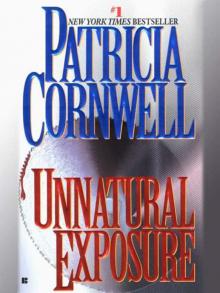 Unnatural Exposure
Unnatural Exposure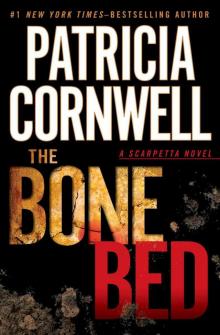 The Bone Bed
The Bone Bed Book of the Dead
Book of the Dead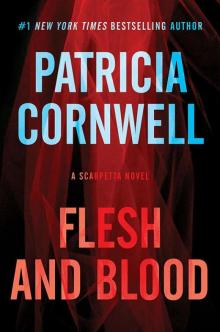 Flesh and Blood: A Scarpetta Novel (Scarpetta Novels Book 22)
Flesh and Blood: A Scarpetta Novel (Scarpetta Novels Book 22)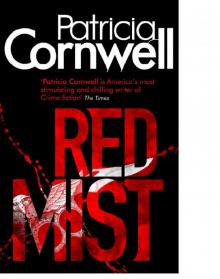 Red Mist
Red Mist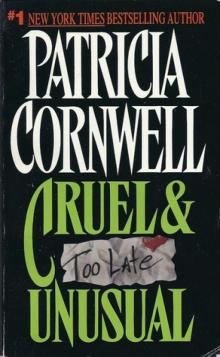 Cruel & Unusual
Cruel & Unusual Hornet's Nest
Hornet's Nest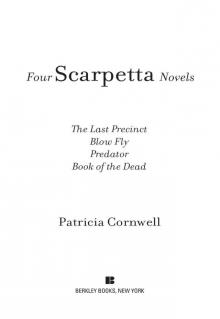 Four Scarpetta Novels
Four Scarpetta Novels Scarpetta's Winter Table
Scarpetta's Winter Table Isle of Dogs
Isle of Dogs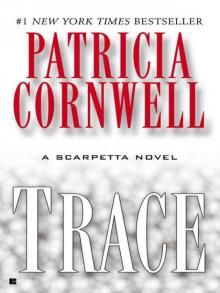 Trace
Trace Postmortem
Postmortem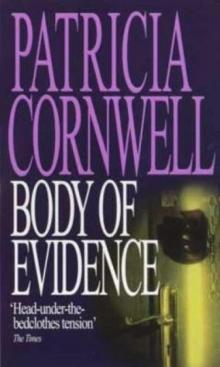 Body of Evidence ks-2
Body of Evidence ks-2 Southern Cross
Southern Cross All That Remains
All That Remains Point of Origin
Point of Origin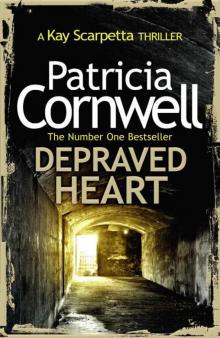 Depraved Heart
Depraved Heart Ruth, a Portrait: The Story of Ruth Bell Graham
Ruth, a Portrait: The Story of Ruth Bell Graham From Potter's Field
From Potter's Field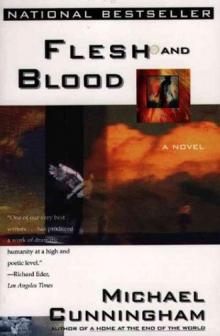 Flesh and Blood
Flesh and Blood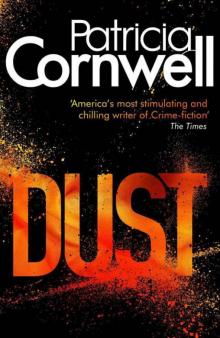 Dust
Dust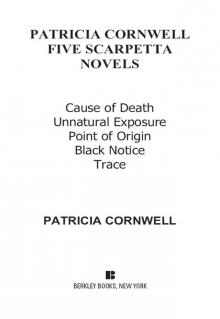 The Body Farm
The Body Farm Port Mortuary
Port Mortuary Quantum
Quantum Portrait of a Killer: Jack the Ripper - Case Closed
Portrait of a Killer: Jack the Ripper - Case Closed Spin (Captain Chase)
Spin (Captain Chase)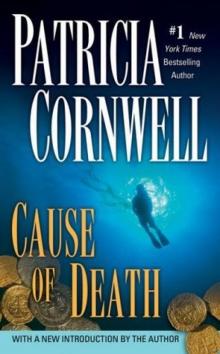 Cause of Death
Cause of Death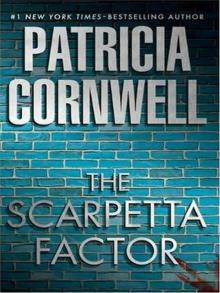 The Scarpetta Factor
The Scarpetta Factor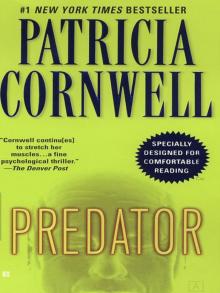 Predator
Predator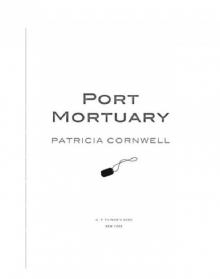 Scarpetta 18 - Port Mortuary
Scarpetta 18 - Port Mortuary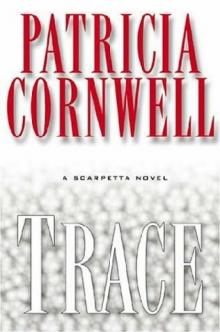 Trace ks-13
Trace ks-13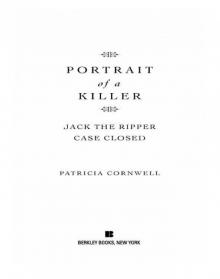 Portrait of a Killer
Portrait of a Killer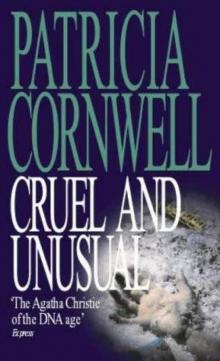 Cruel and Unusual ks-4
Cruel and Unusual ks-4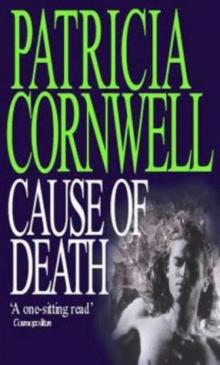 Cause Of Death ks-7
Cause Of Death ks-7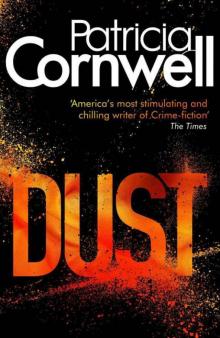 Dust ks-21
Dust ks-21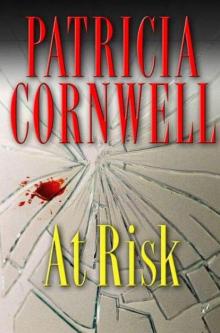 At Risk wg-1
At Risk wg-1 The Last Precinct ks-11
The Last Precinct ks-11 Book of the Dead ks-15
Book of the Dead ks-15 All That Remains ks-3
All That Remains ks-3 Ruth, a Portrait
Ruth, a Portrait Scarpetta's Winter Table (kay scarpetta)
Scarpetta's Winter Table (kay scarpetta) From Potter's Field ks-6
From Potter's Field ks-6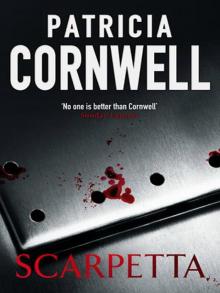 Scarpetta
Scarpetta Isle of Dogs jhabavw-3
Isle of Dogs jhabavw-3 Hornet's Nest jhabavw-1
Hornet's Nest jhabavw-1 The Body Farm ks-5
The Body Farm ks-5 Blow Fly ks-12
Blow Fly ks-12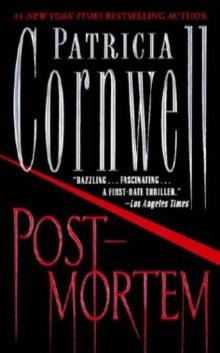 Post Mortem
Post Mortem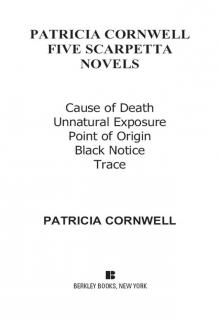 Five Scarpetta Novels
Five Scarpetta Novels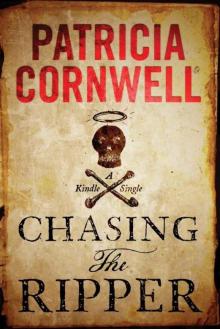 Chasing the Ripper (Kindle Single)
Chasing the Ripper (Kindle Single) Point of Origin ks-9
Point of Origin ks-9 Port Mortuary (2010)
Port Mortuary (2010)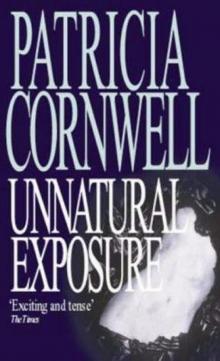 Unnatural Exposure ks-8
Unnatural Exposure ks-8 Southern Cross uhabavw-2
Southern Cross uhabavw-2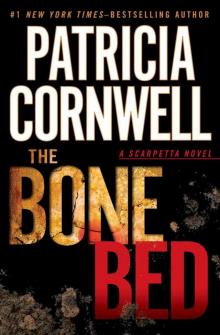 The Bone Bed ks-20
The Bone Bed ks-20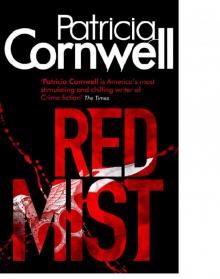 Red Mist ks-19
Red Mist ks-19 Port Mortuary (2010) ks-18
Port Mortuary (2010) ks-18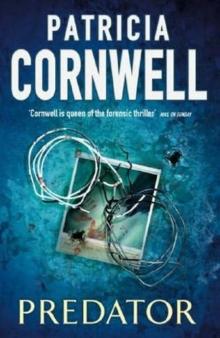 Predator ks-14
Predator ks-14